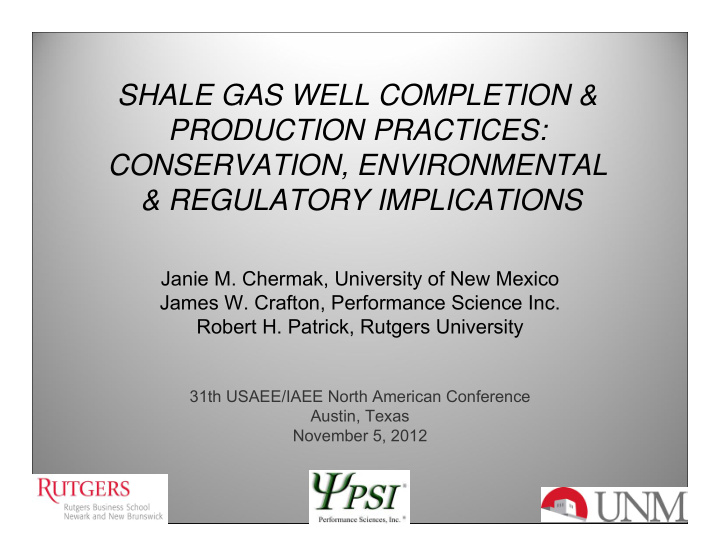



SHALE GAS WELL COMPLETION & PRODUCTION PRACTICES: CONSERVATION, ENVIRONMENTAL & REGULATORY IMPLICATIONS Janie M. Chermak, University of New Mexico James W. Crafton, Performance Science Inc. Robert H. Patrick, Rutgers University 31th USAEE/IAEE North American Conference Austin, Texas November 5, 2012
Shale Gas Plays
THE US SHALE GAS INDUSTRY • US PRODUCTION - 2000: 0.4 trillion cubic feet (TCF) - 2008: 2.0 TCF - 2009: 3.1 TCF - 2010: 5.3 TCF (23% of total production) •2035 FORECAST - 13.6 TCF (49%) - RANGE: 9.7 TCF – 20.5 TCF •RESERVES ? (EIA AEO 2012)
Regulatory Concerns • Environmental • Conservation • Energy Policy
Research • Actual production - reservoir characteristics - well characteristics - capital choices (completion and re-completion) - production choices • Ultimate recovery may depend on - all of the above and - early management production decisions
The Firm’s Problem Choose the initial (and periodic) capital investment(s) R ( j ) R ( j ) u ( R ( j ), K j , j ), j 1,..., k and production path h A t , Z t , K j q t to max profits over the life of the well Z t k T r j v ( R ( j e rt ), K j , j ) P ( t ) q ( t ) w t dt e , 0 j 1 subject to: , and R ( T ) 0, R 0 A 0 , K 0 � R j ( t ) s [ A , K j , R , q , t ], R 0
Econometric Model M ln Q it 0 j ln Z ijt j ln A ijt F ln F it C ln C it j D ijt e 1 it j 1 j A j D it 0 j ln K ijt j ln A ijt j D ijt e 2 it ln F j K j A j D ln C it 0 j ln K ijt j ln A ijt j D ijt e 3 it j K j A j D
Data • 111 shale gas wells located in the US - 39 horizontal wells - 72 vertical wells • all wells began production since 2007 • have between 30 and 720 days of production data • reservoir characteristics • completion and production choices
• RESERVIOR CHARACTERISTICS - permeability thickness - initial reservoir pressure - perforated interval • COMPLETION - hydraulic fracturing fluid - proppant - Injection rate - treating pressure - stages - surfactant concentration - winter fracture - time to complete •THE RESULTING COMPLETION PARAMETERS - fracture Half-length: final and early - fracture Conductivity • MANAGEMENT AND TIME - 10, 30, 60, 90, 1870, 360, 720 days - ratio: production days to calendar days
BASIC RESULTS • Consistency across technologies in EQ1 - Initial Reservoir Pressure (+), - Permeability Thickness (+) - Fracture Half Length (+), - Dimensionless Fracture Conductivity (+), - Difference (-), - Days (i = 30, 60, 90, 180, 360, 720). - CNF (+) • Consistency across EQ2 and EQ3 But these only include the direct impacts from each equation
Direct and Indirect Effects t K im 0 ( h it K im 0 Q i t � � � � � 0 direct h it F im 0 F im 0 K im 0 � � � � � � � � � indirect h it C im 0 C im 0 K im 0 ) � � � � dx � � � � � � � indirect
CUMULATIVE PRODUCTION ELASTICITIES VERTICAL HORIZONTAL Variable Elasticity SE Prob>0 Elasticity SE Prob>0 Reservoir Characteristics Initial Reservoir Pressure 2.335 0.33 1 0.521 0.234 0.987 Permeability Thickness 0.564 0.027 1 0.44 0.029 1 Perforated Interval 0.075 0.068 0.863 n.a. n.a. n.a. Completion Outcomes Final Fracture Half-length 0.509 0.088 1 0.354 0.046 1 Early Fracture Half-length 0.177 0.034 1 0.268 0.037 1 Dimensionless Fracture Conductivity 0.433 0.219 0.976 0.213 0.135 0.943 Completion Choices CnF 0.062 0.029 0.984 2.251 0.486 1 Surfactant n.a. n.a. n.a. -0.027 0.016 0.055 Average Proppant per Stage 0.0017 0.029 0.523 -0.182 0.102 0.037 Proppant Concentration 0.11 0.057 0.972 0.213 0.135 0.943 Average Injection Rate 0.027 0.042 0.738 0.237 0.056 1 Average Treatment Pressure -0.314 0.124 0.006 n.a. n.a. n.a. Difference -0.221 0.035 0 -0.124 0.034 0 Stages n.a. n.a. n.a. 0.19 0.047 1 Production Ratio 0.541 0.218 0.994 -0.00088 0.0414 0.491 SAME SIGN; DIFFERENT SIGN
DISCRETE EFFECT IMPACTS ON CUMULATIVE PORDUCTION VERTICAL HORIZONTAL Variable Semi-elasticity SE Prob>0 Semi-elasticity SE Prob>0 Completion Choices Winter Fracture -0.0064 0.04 0.436 -0.0814 0.079 0.151 CnF Intercept n.a. n.a. n.a. 15.351 3.3 1
Summary • Reservoir characteristics expected impact, but different magnitudes • Completion outcomes consistent but diminishing returns • Completion choices vary • CnF positive impact
Conclusions • Vertical and horizontal wells respond differently • Conventional wisdom from vertical well history may not be appropriate for horizontal wells. • Results are preliminary and only for early period production • On-going research with expanded data set
Regulatory Implications • Shale gas completions and production choices may impact ultimate recovery What does this imply for natural gas as a transition energy source? What does this imply for conservation regulation? • Bigger completions jobs may not always be better Does this have environmental implications? • CnF, a relatively benign additive out performs traditional surfactants What does this imply for environmental regulation?
Thank you. Working paper with technical details: http://papers.ssrn.com/sol3/papers.cfm?abstra ct_id=2162486 and http://www.rci.rutgters.edu/~rpatrick/hp.html Questions and comments: rpatrick@rutgers.edu
Horizontal and Vertical Wells
DATA DESCRIPTION
DESCRIPTIVE STATISTICS
HORIZONTAL RESULTS
VERTICAL RESULTS
Forecast Contributions of Shale Gas From EIA Early Release AEO 2012
Recommend
More recommend